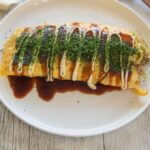
Pork and Cabbage Omelette (Tonpeiyaki) is a dish popular in the Kansai region. Plenty of shredded cabbage and thinly sliced pork are sautéed, then wrapped in an omelette. Sweet fruity tonkatsu sauce and mayonnaise are a must. Watch the video.
Don't forget to see the section 'MEAL IDEAS' below the recipe card! It gives you a list of dishes that I have already posted and this recipe that can make up a complete meal. I hope it is of help to you.
- 200g/7.1oz cabbage cut to 5mm/3⁄16" wide strips
- 80g/2.8oz sliced pork thinly sliced and cut into bite size pieces (note 1)
- 1 tsp dashi powder (note 2)
- 1 tsp mirin
- 1 tsp soy sauce
- 1 tsp oil (note 3)
- 2 eggs beaten
- 1 tbsp corn flour/cornstarch
- 1 tbsp sake (or water)
- A pinch of salt
- 2 tsp oil
- Tonkatsu sauce (note 4)
- Mayonnaise (Kewpie brand suits best)
- Aonori (or finely chopped green onion)
-
Heat oil in a frying pan (note 5) over medium heat. Add pork and sauté for a minute or so until the colour of the pork changes to whitish.
-
Add cabbage to the pan and sauté until the cabbage pieces become wilted. About 3-5 minutes.
-
Add the rest of the Filling ingredients and mix well, then transfer the filling to a bowl.
-
Put corn flour/cornstarch, sake, and a pinch of salt in a small container and mix well ensuring that the mixture is runny with no dense corn flour/cornstarch at the bottom (note 6).
-
Add the diluted corn flour/cornstarch to the beaten egg and mix well (note 6).
-
Wipe the frying pan with a kitchen paper, and heat oil over medium low heat.
-
Pour the egg into the frying pan. As the bottom of the egg starts cooking, mix the egg slightly to make the omelette fluffy.
-
While the surface of the egg is still slightly wet, place the filling in the middle of the egg, spreading one direction so that you will have a band of the filling on the egg. You should have about the similar width of the egg-only portion on both sides of the filling.
-
Using a spatula, lift one side of the egg-only portion and gently cover the filling. The omelette becomes a shape of wide half circle.
-
Turn the heat off and rotate the omelette so that the straight line of the omelette is aligned to the handle of your frying pan and the round side of the omelette is on the left side of the handle (for the right handers).
-
Place the frying pan on the edge of a serving place, tilting slightly so that the omelette can easily slide onto the plate.
-
Place the spatula underneath the omelette from the straight side, then in one motion flip it over onto the plate. Both sides of the omelette should be tucked in (note 7).
-
Drizzle tonkatsu sauce over the omelette drawing a narrow zig-zag pattern. Do the same with mayonnaise, then sprinkle aonori over.
-
Serve to share or cut into half and serve individually while hot.
1. I used thinly sliced (about 2mm/3⁄32" thick) pork belly strips cut into 4-5cm/1½-2" long pieces. It is best to use very thin slices.
You can use other cuts of pork slices if you want to cut down calories.
2. I used the powdered katsuobushi in a sachet. Dashi sachet is usually boiled to get dashi stock out of it, but I cut the sachet open and used the powder in it.
If you are using granular bonito-flavoured seasoning instead, you will only need ½ teaspoon of it.
3. I only used a small amount of oil to cook fillings because the pork belly came with quite a bit of fat. If you are using lean pork, you may want to double the quantity of oil.
4. I used the Bulldog brand tonkatsu sauce. You can find more details about Bulldog sauces in my post Yakisoba.
If you only have Worcestershire sauce, you can mix 1 part Worcestershire sauce with 1 part ketchup and a small amount of sugar.
5. I used 26cm/10" frying pan, which is about the right size to make a Tonpeiyaki for 2 servings. If your frying pan is too small, the filling will be too much for the size of your omelette. If the pan is too large, your omelette will be too thin.
If you are making 4 servings, you have an option of making two omelettes as per the recipe instructions or use a larger frying pan and make a big Tonpeiyaki.
6. This can be done before cooking fillings.
7. If the omelette was not tidy, that's OK. You can use a hand and the spatula to tuck the sides of the omelette in. If the fillings that are scattered outside of the omelette, push them underneath the omelette.
8. Nutrition per serving. I used pork belly which increased the calories and the fat figures. If you use lean pork, you can significantly reduce these.
serving: 213g calories: 393kcal fat: 33g (51%) saturated fat: 9.8g (49%) trans fat: 0.1g polyunsaturated fat: 4.5g monounsaturated fat: 17g cholesterol: 215mg (72%) sodium: 318mg (13%) potassium: 341mg (10%) carbohydrates: 10g (3%) dietary fibre: 2.8g (11%) sugar: 4.5g protein: 12g vitamin a: 7.6% vitamin c: 61% calcium: 5.5% iron: 9.4%